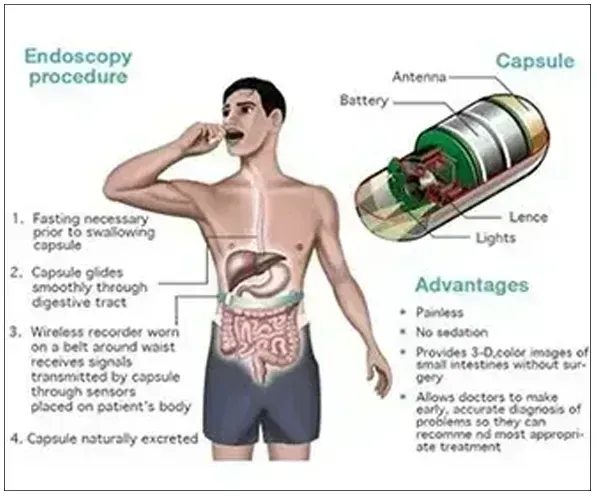


The estimated annual incidence of gastrointestinal bleeding in the United States is approximately 100 episodes per 100,000 persons resulting in 300,000 hospitalizations annually. Diagnostic tools such as radiologic studies and endoscopic examination often fail to identify a source of bleeding, resulting in a cycle of repetitive testing over months or even years. Costs associated with the diagnostic process, and with interim treatment for anemia and other symptoms can be significant. The diagnostic process also takes a toll on the patient, in terms of worry, pain and discomfort.
Capsule Endoscopy, a technology that received FDA clearance in August 2001, consists of a video capsule that is ingested by the patient, and that transmits images to a wireless data recorder worn on the belt.
The Capsule Endoscope is a disposable video endoscope measuring 11x26 mm. Like traditional endoscopes, the capsule endoscope contains an integrated light source, video chip, energy source, and transmitter. Like the sonde endoscope, it is ingested by the patient and advances through the GI tract through peristalsis.
The capsule is naturally excreted. The sensor array is worn on the abdomen and receives images and data from the capsule endoscope. The sensors pass the video images to the Data Recorder, which the patient wears on a belt. The belt permits patients to continue with normal daily activities during the examination.
The capsule endoscope provides direct color video images of the GI mucosa at a rate of 2 images per second for approximately 8 hours; the patient procedure is now complete. The recorded stream of approximately 50,000 images can be viewed on a computer workstation by a physician to identify nature and location of potential sources of bleeding.
Capsule Enteroscopy enables the physician to appropriately diagnose symptomatic patients, which may lead to effective treatment, better patient management, and a higher quality of patient care.
Unlike radiologic imaging procedures, capsule enteroscopy allows detailed (up to 0.1 millimeter resolution) visualization of the small intestine. This increases the possibility of locating and diagnosing pathologies in the small intestine that may otherwise go undetected.
Capsule endoscopy is a promising new technology on many levels. Its diagnostic yield is high, with the potential to result in earlier diagnosis. This in turn can result in more timely treatment and lower overall utilization and cost. Capsule endoscopy may greatly improve patient safety and reduce the occurrence of adverse events associated with more invasive exploratory diagnostic procedures. Humanistic outcomes such as patient comfort, satisfaction, quality of life, and productivity, all appear to be significantly improved as well.